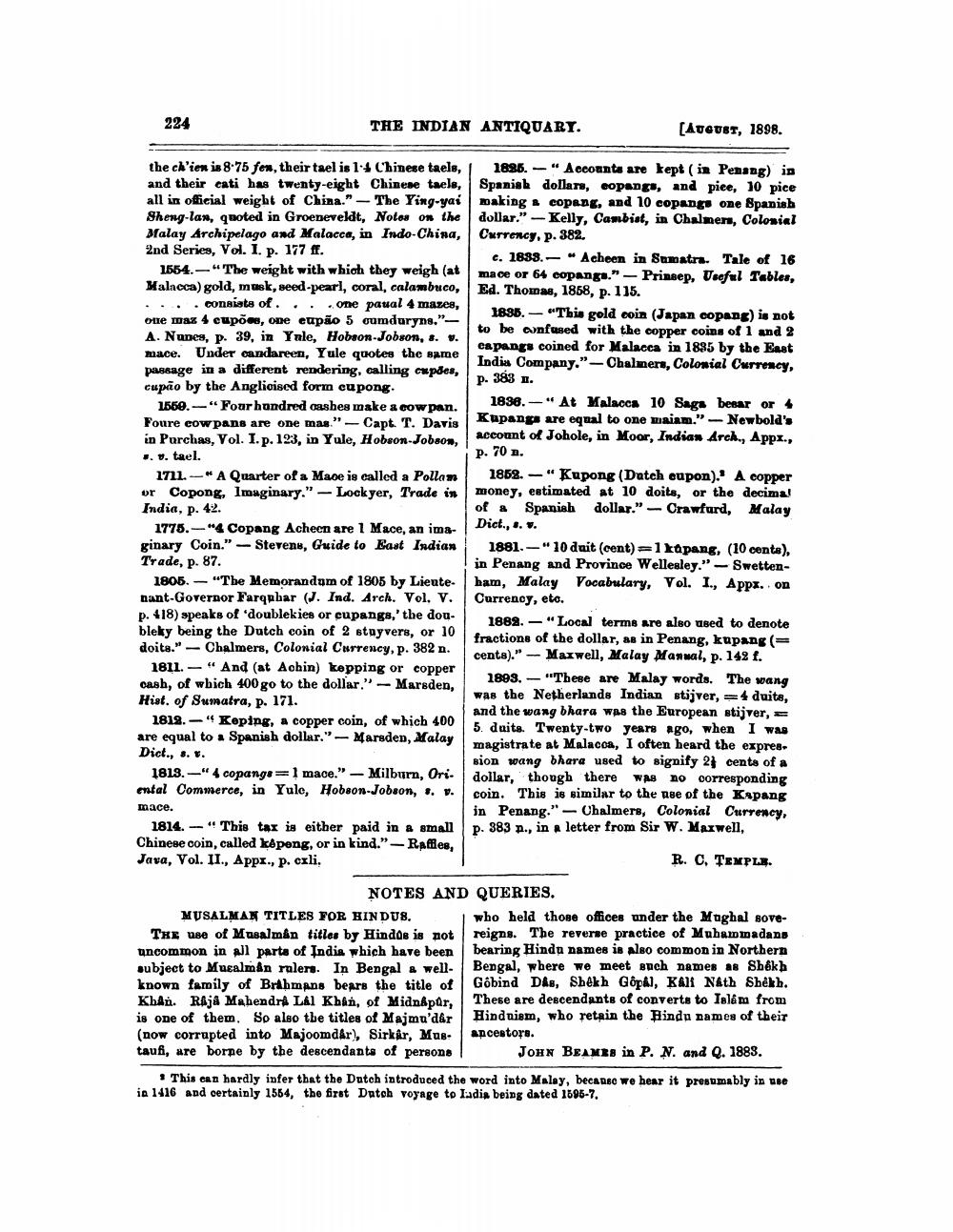________________
224
THE INDIAN ANTIQUARI.
[AUGUST, 1898.
the ch'ien is 8.75 fen, their tael is 14 Chinese taels,1 1826. - "Accounts are kept ( in Penang) in and their cati has twenty-eight Chinese taels, Spanisk dollars, copang, and pice, 10 pice all in official weight of China." - The Ying-yai making copang, and 10 copangs one Spanish Sheng.lan, quoted in Groeneveldt, Nolas on the dollar." - Kelly, Cambist, in Chalmer, Colonial Malay Archipelago and Malacca, in Indo-China, Currency, p. 382. 2nd Series, Vol. 1. p. 177 ff.
c. 1838.- Acheen in Sumatra. Tale of 16 1554.-" The weight with which they weigh (at mace or 64 copanga." - Prinsep, Vseful Tables, Malacca) gold, musk, seed-pearl, coral, calambuco, Ea. Thomas, 1868, p. 115. .... consists of ....one paual 4 mazes,
1836. - "This gold coin (Japan copang) is not one maz 4 eupões, one cupão 5 cumduryns." - A. Nunes, p. 39, in Yale, Hobson-Jobson, 8. .
to be anfused with the copper coins of 1 and 2
ea pangs coined for Malacca in 1885 by the East mace. Under candareen, Yule quotes the same
India Company."-Chalmera, Colonial Currency, passage in a different rendering, calling opdes,
p. 383 .. cupão by the Anglicised form cupong. 1560.--"Pour hundred easbes make a cow pan.
1836. - " At Malacca 10 Saga besar or 4 Foure cow pans are one mas." - Capt. T. Davis
Kupanps are equal to one maiam." -Newbold's in Purchas, Vol. I. p. 123, in Yule, Hobson-Jobson,
account of Johole, in Moor, Indian Arch., Appi., .. u. tael.
p. 70 n. 1711.-"A Quarter of a Maoe is called a Pollan
1862. -"Kupong (Datch oupon).' A copper or Copong. Imaginary." - Look yer. Trade in money, estimated at 10 doits, or the decima! India, p. 42.
of a Spanish dollar." - Crawfurd, Malay 1775.-" Copang Acheen are 1 Mace, an ima
Dict., ... ginary Coin." - Stevens, Guide to East Indian 1881.-" 10 duit (cent)=1 kapang, (10 centa), Trade, p. 87.
in Penang and Province Wellesley." -Swetten1805. - "The Memorandum of 1805 by Lieute ham, Malay Vocabulary, Vol. I., Appx.. on nant-Governor Farquhar (J. Ind. Arch. Vol. V. Currency, eto. p. 418) speaks of 'doublekies or cupanga,' the dou
1889. - "Local terms are also used to denote bleky being the Dutch coin of 2 stayvers, or 10
fractions of the dollar, as in Penang, kupang doits." - Chalmers, Colonial Currency, p. 382 n.
centa)." - Maxwell, Malay Manwal, p. 142 f. 1811. - " And (at Achin) kepping or copper
1899. - "These are Malay words. The wang cash, of wbich 400 go to the dollar." - Marsden,
was the Netherlands Indian stijver, 4 duits, Hist. of Sumatra, p. 171.
and the wang bhara was the European stijver, = 1812. - "Keping, a copper coin, of which 400
5. duits. Twenty-two years ago, when I was are equal to Spanish dollar." - Marsden, Malay
magistrate at Malacca, I often heard the expres Dict., 8. v.
sion wang bhara used to signify 2 cents of a 1813. -" 4 copange=1 mace." - Milburn, Ori. dollar, though there was no corresponding ental Commerce, in Yule, Hobson-Jobson, $. v. coin. This is similar to the use of the Kapang mace.
in Penang." - Chalmers, Colonial Currency, 1814. - " This tax is either paid in a small p. 383 p., in letter from Sir W. Maxwell, Chinese coin, called kopeng, or in kind." - Rafles, Jasa, Vol. II., Appz., p. cxli.
R. C, TEMPLE. NOTES AND QUERIES. MUSALMAN TITLES FOR HINDUS. who held those offices under the Mughal soveTHE use of Musalman titles by Hindde is not reigns. The reverse practice of Muhammadans uncommon in all parts of India which have been bearing Hindu names is also common in Northern subject to Muealman rulers. In Bengal # well- Bengal, where we meet euch names as Shekh known family of Brahmans bears the title of Gobind Dås, Shekh Göpal, KAJ Nath Shekh. Khan. Raja Mahendra Lal Khan, of Midnapor, These are descendants of converts to Islam from is one of them. So also the titles of Majmu'dar Hinduism, who retain the Hindu names of their (now corrupted into Majoomdár), Sirkar, Mus. ancestors. taufi, are borne by the descendants of persons | JOHN BEANBS in P. N. and Q. 1888.
This can hardly infer that the Dutch introduced the word into Malay, became we hear it presumably in use in 1416 and certainly 1564, the first Datoh voyage to ladis being dated 1595-7.




